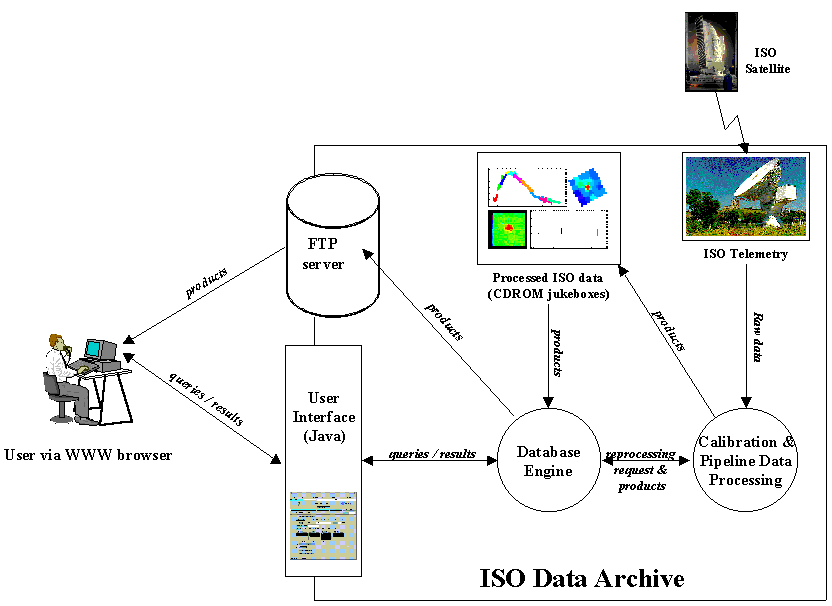 |
It is available at http://www.iso.vilspa.esa.es/ and has serviced over 5000 requests for data since its release on 9th of December 1998.
The ISO Data Archive is setting new standards in astronomical archive with the first full JAVA interface. Its intuitive and configurable user interface allows both the general astronomer and the instrument expert to make complex queries of the database, have a quick textual and visual look at the data before retrieving the observations with a wide variety of options.
The User Requirements were mainly expressed as:
The user selects the parameters of interest and clicks to submit the query form. The inputs are translated by the ISO Data Archive JAVA applet into an SQL query which is made directly to a SYBASE database engine running on the server, using a specific JAVA interface for SYBASE. Before submission, an expert user has the opportunity of editing the SQL query generated by the form to add in any extra parameters which are not available from the main panel or the sub-panels. A list of observations matching the query is returned into a latest results page with a thumbnail sketch, for each observation, called an icon. This gives a small view of the final scientific product, which may be either an image or a spectrum. To get an idea of the scientific quality of the observation a user may click on the icon and bring up, in a different window, an expanded view of the scientific product called a postcard which contains some explanatory text and is stored internally as a GIF file.
To retrieve data, a user must register providing a username, password and an E-mail address. From the latest results page, on can then move observations to the shopping basket. This is a list of the observations which the user wishes to retrieve and may be added to by making more queries and selections until the total request is ready to be submitted. From the shopping basket panel, a wide variety of levels of desired products (including a custom selection) for each observation may be specified. The standard set of products is stored on CDROM jukeboxes with four parallel readers. The user may select these or may elect to have the observation reprocessed by the latest version of the calibration software7. Files are returned either by FTP, in a variety of user-selectable compression formats, or on a CDROM which is mailed to the user.
At the start of the development, it was decided, in conjunction with the users, to adopt JAVA as the programming language for the user interface. At that time, in 1997, the choice could be seen as somewhat risky since JAVA was not so stable within the WWW browsers. Nonetheless, its many advantages made it an obvious choice.
Instead of using many standard WWW forms associated with cgi-bin scripts written in perl or C, JAVA allows integration of many facilities into a single application. Using the JAVA Object Oriented approach, the interface is made of modular and ``living'' components such as on-line help, subpanels, input fields according to other parameters. Control of displayed components on the screen is made easier and handling of quick-look data (icons, postcards) is more efficient. Moreover, this approach allows some level of user configurability.
JAVA also offers the possibility of doing various tasks in parallel, like consulting the help while querying the database. Once the ISO Data Archive JAVA applet (current size is 400 kB) has been downloaded to the user machine, many operations are made on the client machine using its own computer resources (CPU, memory). This avoids unnecessary interactions with the ISO Data Archive server and makes the access faster.
Using the JAVA Object Oriented approach and the Model View Controller (MVC) paradigm, the ISO Data Archive is modular and flexible, much easier to maintain, and with source code documentation automatically generated. This approach is particularly appropriate for developing complex and portable graphical user interfaces viewable through WWW browsers. Developing and maintaining such an archive using WWW forms and cgi-bin scripts would have increased the effort dramatically.
However, using new technologies was not problem-free. The first beta releases suffered from the then-poor implementation of JAVA in the most popular WWW browsers. To circumvent this, without extra effort, a standalone JAVA application of the ISO Data Archive was made available. This can be installed at the user site and runs outside a browser, thereby avoiding WWW browser JAVA instability. But with various beta releases and the improvement of the WWW browsers, the first release of the ISO Data Archive in December 1998 was very stable and reliable in both standalone and browser environment and the choice of JAVA definitely paid off.
The ISO Data Archive is still being actively and continuously improved. In particular, it is planned to bring the following new features in future releases:
Osuna, P., Arviset, C., Pollock, A., Saxton, R. D., & Verdugo, E. 2000, this volume, 195
Saxton, R. D. et al. 1998, in ASP Conf. Ser., Vol. 145, Astronomical Data Analysis Software and Systems VII, ed. R. Albrecht, R. N. Hook, & H. A. Bushouse (San Francisco: ASP), 438